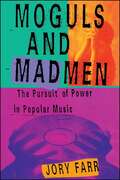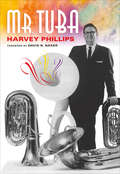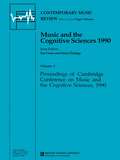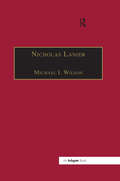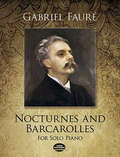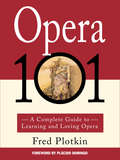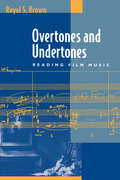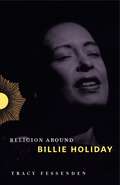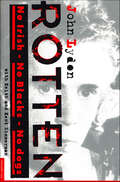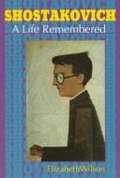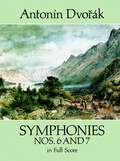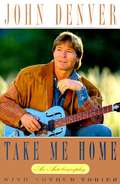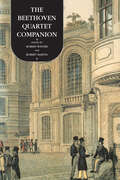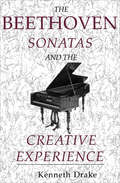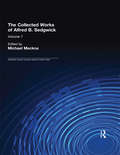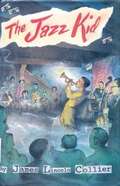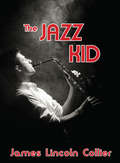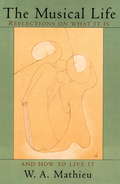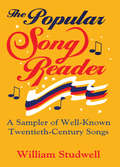- Table View
- List View
Moguls And Madmen: The Pursuit of Power in Popular Music
by Jory FarrFrom Simon & Schuster, Moguls and Madmen is Jory Farr's guide to the pursuit of power in popular music. As Jory Farr describes in the prologue of Moguls and Madmen, "this book is not for them [multi millionaire super scouts and corporate executives], however. It's for all the musicians—and the musicians to come—who want to know what they're up against."
Mr. Tuba
by Harvey PhillipsThe autobiography of &“possibly the greatest tuba player of all time&” (New York Times), the man who &“put class in the low brass.&” (Clark Terry, jazz trumpeter) With warmth and humor, tuba virtuoso Harvey Phillips tells the story of his amazing life and career—from his Missouri childhood through his days as a performer with the King Brothers and the Ringling Bros. and Barnum & Bailey circuses, his training at the Juilliard School, a stint with the U.S. Army Field Band, and his freelance days with the New York City Opera and Ballet. A founder of the New York Brass Quintet, Phillips served as vice president of the New England Conservatory of Music and became Distinguished Professor of Music at Indiana University. The creator of an industry of TubaChristmases, Octubafests, and TubaSantas, he crusaded for recognition of the tuba as a serious musical instrument, commissioning more than 200 works. Enhanced by an extensive gallery of photographs, Mr. Tuba conveys Phillips&’s playful zest for life while documenting his important musical legacy. &“Mr. Tuba is not only a memoir, but it is a history of the twentieth century American music world and a resource for all music teachers and music lovers.&” —NBA Journal &“A lively and informative read.&” —Herald-Times &“[Phillips&’s] autobiography is a fitting end to his life&’s works, underlined with the same sense of inspiration and integrity that informed all of his musical activities.&” —Bloom Magazine
Music and Conflict
by John Morgan O'Connell Salwa El-Shawan Castelo-BrancoThis volume charts a new frontier of applied ethnomusicology by highlighting the role of music in both inciting and resolving a spectrum of social and political conflicts in the contemporary world. Examining the materials and practices of music-making, contributors detail how music and performance are deployed to critique power structures and to nurture cultural awareness among communities in conflict. The essays here range from musicological studies to ethnographic analyses to accounts of practical interventions that could serve as models for conflict resolution. Music and Conflict reveals how musical texts are manipulated by opposing groups to promote conflict and how music can be utilized to advance conflict resolution. Speaking to the cultural implications of globalization and pointing out how music can promote a shared musical heritage across borders, the essays discuss the music of Albania, Azerbaijan, Brazil, Egypt, Germany, Indonesia, Iran, Ireland, North and South Korea, Uganda, the United States, and the former Yugoslavia. The volume also includes dozens of illustrations, including photos, maps, and musical scores. Contributors are Samuel Araujo, William Beeman, Stephen Blum, Salwa El-Shawan Castelo-Branco, David Cooper, Keith Howard, Inna Naroditskaya, John Morgan O'Connell, Svanibor Pettan, Anne K. Rasmussen, Adelaida Reyes, Anthony Seeger, Jane C. Sugarman, and Britta Sweers.
Music and the Cognitive Sciences 1990 (Contemporary Music Review)
by Ian Cross Irene DeliegeThis issue comprises the twenty-five papers presented at the Second Music and the Cognitive Sciences conference held at Cambridge University in 1990.
Nicholas Lanier: Master of the King's Musick
by MichaelI. WilsonNicholas Lanier (1588-1666) was not only the first person to hold the office of Master of the Music to King Charles I, he was also a practising painter, a friend of Rubens, Van Dyck and many other artists of his time, and one of the very first great art collectors and connoisseurs. He is especially remembered for the part he played in acquiring, on behalf of Charles I, the famous collection of paintings belonging to the Gonzaga family of Mantua. Many of these paintings still form an important part of the Royal Collection today. In this book the different strands of Lanier's colourful life are for the first time drawn together and presented in a single compelling narrative.
Nocturnes and Barcarolles for Solo Piano (Dover Classical Piano Music)
by Gabriel FauréThe music of Gabriel Fauré (1845-1924) is an important link between the innovations of late Romanticism and the experimentation of the early 20th century. A student of Saint-Saëns, he, in turn, taught Ravel and was a mentor to the young modernists of Les Six. These 12 nocturnes and 12 barcarolles, composed over a span of 40 years, document his move from Romanticism to the frontiers of 20th-century music. Reprinted from authoritative French editions.
Opera 101: A Complete Guide to Learning and Loving Opera
by Fred PlotkinOpera is the fastest growing of all the performing arts, attracting audiences of all ages who are enthralled by the gorgeous music, vivid drama, and magnificent production values. If you've decided that the time has finally come to learn about opera and discover for yourself what it is about opera that sends your normally reserved friends into states of ecstatic abandon, this is the book for you. Opera 101 is recognized as the standard text in English for anyone who wants to become an opera lover--a clear, friendly, and truly complete handbook to learning how to listen to opera, whether on the radio, on recordings, or live at the opera house. Fred Plotkin, an internationally respected writer and teacher about opera who for many years was performance manager of the Metropolitan Opera, introduces the reader (whatever his or her level of musical knowledge) to all the elements that make up opera, including: A brief, entertaining history of opera; An explanation of key operatic concepts, from vocal types to musical conventions; Hints on the best way to approach the first opera you attend and how to best understand what is happening both offstage and on; Lists of recommended books and recordings, and the most complete traveler's guide to opera houses around the world. The major part of Opera 101 is devoted to an almost minute-by-minute analysis of eleven key operas, ranging from Verdi's thunderous masterpiece Rigoletto and Puccini's electrifying Tosca through works by Mozart, Donizetti, Rossini, Offenbach, Tchaikovsky, and Wagner, to the psychological complexities of Richard Strauss's Elektra. Once you have completed Opera 101, you will be prepared to see and hear any opera you encounter, thanks to this book's unprecedentedly detailed and enjoyable method of revealing the riches of opera.
Overtones and Undertones: Reading Film Music
by Royal S. BrownSince the days of silent films, music has been integral to the cinematic experience, serving, variously, to allay audiences' fears of the dark and to heighten a film's emotional impact. Yet viewers are often unaware of its presence. In this bold, insightful book, film and music scholar and critic Royal S. Brown invites readers not only to "hear" the film score, but to understand it in relation to what they "see."Unlike earlier books, which offered historical, technical, and sociopolitical analyses, Overtones and Undertones draws on film, music, and narrative theory to provide the first comprehensive aesthetics of film music. Focusing on how the film/score interaction influences our response to cinematic situations, Brown traces the history of film music from its beginnings, covering both American and European cinema. At the heart of his book are close readings of several of the best film/score interactions, including Psycho, Laura, The Sea Hawk, Double Indemnity, and Pierrot le Fou. In revealing interviews with Bernard Herrmann, Miklós Rósza, Henry Mancini, and others, Brown also allows the composers to speak for themselves. A complete discography and bibliography conclude the volume.
Pride: The Charley Pride Story
by Charley PrideCharley Pride made history when he became the first widely accepted black country music singer. Born the son of a poor farmer, Charley planned to become a Major League baseball player. In fact, he spent several years playing baseball before an injury caused him to rethink his plans. In the early 1960s, country music stars were white, and so were the producers. Few people gave Charley the time of day. With the help of Red Sovine and a producer in Nashville, Charley's first records were released. The catch was that no one knew he was black. His album cover showed a blurry photo. This is the story of how a shy man from Mississippi changed the face of country music forever while battling depression and his own fears.
Religion Around Billie Holiday (Religion Around)
by Tracy FessendenSoulful jazz singer Billie Holiday is remembered today for her unique sound, troubled personal history, and a catalogue that includes such resonant songs as “Strange Fruit” and “God Bless the Child.” Holiday and her music were also strongly shaped by religion, often in surprising ways. Religion Around Billie Holiday examines the spiritual and religious forces that left their mark on the performer during her short but influential life.Mixing elements of biography with the history of race and American music, Tracy Fessenden explores the multiple religious influences on Holiday’s life and sound, including her time spent as a child in a Baltimore convent, the echoes of black Southern churches in the blues she encountered in brothels, the secular riffs on ancestral faith in the poetry of the Harlem Renaissance, and the Jewish songwriting culture of Tin Pan Alley. Fessenden looks at the vernacular devotions scholars call lived religion—the Catholicism of the streets, the Jewishness of the stage, the Pentecostalism of the roadhouse or the concert arena—alongside more formal religious articulations in institutions, doctrine, and ritual performance.Insightful and compelling, Fessenden’s study brings unexpected materials and archival voices to bear on the shaping of Billie Holiday’s exquisite craft and indelible persona. Religion Around Billie Holiday illuminates the power and durability of religion in the making of an American musical icon.
Rock Bottom: Dark Moments in Music Babylon
by Pamela Des BarresThe dark moments of rock history fascinate and tantalize like the pathos of Greek tragedy. The bottom sinks lower, the air seems colder, the bad endings--when they are bad--seem beyond bad. The unlucky practitioners of our most thriving form of communal experience seem to hit rock bottom in ways only the most glamorous among us can--publicly. The stories remain obscure, half-seen in the shadowlands. In her familiar style, Pamela Des Barres shines light on the people whose art remains the background music to our popular culture.Des Barres asks, "What comes first, the addiction or the rock and roll?" The first apparent rock-and-roll death occured on Christmas Eve in 1959, when Johnny Ace blew his head off in a game of Russian Roulette between shows. Buddy Holly's four-seater plane crashes. Marvin Gaye's father shoots his son. Kurt Cobain puts a gun to his head. The headlines tell it all: ROCK SINGER FACES MANSLAUGHTER CHARGE, JAMES BROWN ADDICTED TO PCP, BASSIST FOR BAND HOLE FOUND DEAD. The messed-up lives, the burned-out golden boys and girls, the violence, the route toward rock bottom--Des Barres has a line on the souls of the public figures who lived desperate private lives to entertain us all.
Rotten: No Irish, No Blacks, No Dogs
by Keith Zimmerman Kent Zimmerman John Lydon"I have no time for lies and fantasy, and neither should you. Enjoy or die..." --John LydonPunk has been romanticized and embalmed in various media. An English class revolt that became a worldwide fashion statement, punk's idols were the Sex Pistols, and its sneering hero was Johnny Rotten.Seventeen years later, John Lydon looks back at himself, the Sex Pistols, and the "no future" disaffection of the time. Much more than just a music book, Rotten is an oral history of punk: angry, witty, honest, poignant, crackling with energy. Malcolm McLaren, Sid Vicious, Chrissie Hynde, Billy Idol, London and England in the late 1970s, the Pistols' creation and collapse...all are here, in perhaps the best book ever written about music and youth culture, by one of its most notorious figures.
Say It Loud! The Story of Rap Music
by K. Maurice JonesExplores the origins and development of rap music.
Shostakovich: A Life Remembered
by Elizabeth WilsonShostakovich: A Life Remembered is a unique study of the great composer Dimitri Shostakovich drawn from the reminiscences and reflections of his contemporaries. Using much material never previously published in English, as well as personal accounts from interviews and specially commissioned articles, Elizabeth Wilson has built a fascinating chronicle of Shostakovich's life.
Skeleton Key
by David Shenk Steve SilbermanNOW AN EBOOK FOR THE FIRST TIMEFor fifty years and more than two thousand shows, the Grateful Dead have been earning the "deadication" of more than a million fans. Along the way, Deadheads have built an original and authentic American subculture, with vivid jargon and rich love, and its own legends, myths, and spirituality.Skeleton Key: A Dictionary for Deadheads is the first map of what Jerry Garcia calls "the Grateful Dead outback," as seen through the eyes of the faithful, friends, and family, including Bill Walton, Elvis Costello, Tipper Gore, Al Franken, Bob Bralove, Dick Latvala, Blair Jackson, David Gans, Bruce Hornsby, Rob Wasserman, and Robert Hunter. Skeleton Key puts you on the Merry Pranksters' bus behind the real Cowboy Neal, uncovers the origins of Cherry Garcia, follows the dancing bear on its trip from psychedelic artifact to trademarked icon, and unlocks the Dead's own tape vault.Informative reading for the new fan or the most grizzled "tourhead," Skeleton Key shines throughout with Deadheads' own stories, wit, insiders' knowledge, sincere appreciation of the music of the "band beyond description," and the diverse and soulful culture it inspires.
Symphonies Nos. 6 and 7 in Full Score (Dover Orchestral Music Scores)
by Antonín DvorákWhile the immense popularity of Dvořák's Symphony No. 9, "From the New World," has somewhat overshadowed his other symphonic works, the two symphonies reprinted here are superb compositions in their own right. Indeed, the Symphony No. 7 in D Major is considered by many music authorities to be Dvořák's finest achievement in the symphonic form. Its strong, concise development, great emotional depths, and heroic spirit have won the work many admirers among critics and public alike.Regarding the Symphony No. 6, Grove's Dictionary has this to say: "The joyous Symphony in D Major, Op. 60, full of the fragrance and melody of the Czech fields and forests, full of light and cheerful courage, with the furiant in the scherzo, is a work of striking originality."This handsome, durable volume affords music lovers the opportunity to study these great scores, carefully and accurately reproduced from an authoritative German edition.
Take Me Home: An Autobiography
by John Denver Arthur TobierIn a career that has spanned twenty-five years, John Denver has earned international acclaim as a singer, songwriter, actor, and environmental activist. Songs like "Take Me Home, Country Roads," "Rocky Mountain High," and "Annie's Song" have entered the canon of universal anthems, but less than three decades ago, John Denver was a young man with little more than a fine voice, a guitar, and a dream. Growing up in a conservative military family, he was not expected to drop out of college and head to Los Angeles, where the music scene was flourishing. Nor was he expected to succeed. In Take Me Home, John Denver chronicles the experiences that shaped his life, while unraveling the rich, inner journey of a shy Midwestern boy whose uneasy partnership with fame has been one of the defining forces of his first fifty years. With candor and wit, John writes about his childhood, the experience of hitting L.A. as the Sixties roared into full swing, his first breaks, his years with the Mitchell Trio, his first songwriting success with "Leaving on a Jet Plane," and finally a career that made his a global household name. He also explores his relationships with the women in his life--particularly his first wife, Annie Martell, and his second wife, Cassandra Delaney--as well as his parents, his children, his partners through his life, and his friends. Honest, insightful and rich in anecdotes that only a natural-born storyteller could tell so well, Take Me Home is a highly charged and fascinating book from beginning to end. It's like spending a couple of days with a good friend.
The Beethoven Quartet Companion
by Robert Martin Robert WinterWhile the Beethoven string quartets are to chamber music what the plays of Shakespeare are to drama, even seasoned concertgoers will welcome guidance with these personal and sometimes enigmatic works.This collection offers Beethoven lovers both detailed notes on the listening experience of each quartet and a stimulating range of more general perspectives: Who has the quartets' audience been? How were the quartets performed before the era of sound recordings? What is the relationship between "classical" and "romantic" in the quartets? How was their reception affected by social and economic history? What sorts of interpretive decisions are made by performers today?The Companion brings together a matchless group of Beethoven experts. Joseph Kerman is perhaps the world's most renowned Beethoven scholar. Robert Winter, an authority on sketches for the late quartets, has created interactive programs regarded as milestones in multimedia publishing. Maynard Solomon has written an acclaimed biography of Beethoven. Leon Botstein is the conductor of the American Symphony Orchestra as well as a distinguished social historian and college president. Robert Martin writes from his experience as cellist of the Sequoia Quartet. And the book is anchored by the program notes of Michael Steinberg, who has served as Artistic Advisor of the San Francisco Symphony and the Minnesota Orchestra.
The Beethoven Sonatas and the Creative Experience
by Kenneth DrakeThe definitive study of Beethoven&’s piano sonatas is &“remarkable as an insider&’s account of the works in an individual perspective.&” (European Music Teacher) In &“one of the most interesting, useful and even exciting books on the process of musical creation&” (American Music Teacher), Kenneth O. Drake groups the Beethoven piano sonatas according to their musical qualities, rather than their chronology. He explores the interpretive implications of rhythm, dynamics, slurs, harmonic effects, and melodic development and identifies specific measures where Beethoven skillfully employs these compositional devices. An interpreter searching for meaning, Drake begins with Beethoven&’s expressive treatment of the keyboard—the variations of touch, articulation, line, color, use of silence, and the pacing of musical ideas. He then analyzes individual sonatas, exploring motivic development, philosophic overtones, and technical demands. Hundreds of musical examples illustrate this exploration of emotional and interpretive implications of &“the 32.&” Here musicians are encouraged to exercise intuition and independence of thought, complementing their performance skills with logical conclusions about ideas and relationships within the score.
The Collected Works of Alfred B. Sedgwick (Nineteenth-Century American Musical Theater Series #7)
by Michael MecknaFirst Published in 1994. This is volume 7 of a 16-volume series providing comprehensive set of works from a full century of musical theatre in the United States of America. The contents of this volume represent the most ubiquitous, yet probably the least well documented or described forms of musical theatre in the United States during the nineteenth century. Alfred B. Sedgwick, this volume's focus, was one of the most prolific published authors of playlets with music – especially popular with middle-class families whose ancestors had emigrated from the British Isles.
The Jazz Kid
by James Lincoln CollierPlaying the cornet is the first thing that twelve-year-old Paulie Horvath has taken seriously, but his obsession with becoming a jazz musician leads him into conflict with his parents and into the tough underworld of Chicago in the 1920s.
The Jazz Kid
by James Lincoln CollierPaulie Horvath is never going to be a good student like his brother, John, never going to follow his hardworking father into the plumbing trade, never going to ease his mother's mind by passing tests or cleaning up his room. But once he hears jazz by accident from the basement of a speakeasy, he knows exactly what he will do: learn that music and make it his life. Jazz is all around in 1920s gangland Chicago, but not so easy for a twelve-year-old to find, especially when his father disapproves of it. Paulie has to lie, beg, and steal just to get time for lessons, time to practice, time to slip across town to see stars like King Oliver and Louis Armstrong. Lies last only so long until they are found out, and a confrontation is coming. Will he choose home and family or sleazy dives with that wonderful music?
The Musical Life
by W. A. MathieuEveryone, according to W.A. Mathieu, is musical by nature--it goes right along with being human. And if you don't believe it, this book will convince you. In a series of interrelated short essays, Mathieu takes the reader on a journey through ordinary experiences to open our ears to the rich variety of music that surrounds us but that we are trained to ignore; such as the variety of pitches produced by different objects, like glassware, furniture, drums--anything you can tap; or sounds that hover on the border of music, like laughter, the clinking of glasses in a toast, or the unintentional falsetto produced by yawning. Along the way the author teaches aspects of music theory that nonmusicians might ordinarily shy away from. He reveals the way of music to be a profoundly spiritual path--one that is everyone's birthright.
The Popular Song Reader: A Sampler of Well-Known Twentieth-Century Songs
by Frank Hoffmann William E Studwell Beulah B RamirezWho is the Bill Bailey whose exploits were chronicled in song? How many popular songs have titles containing the words “moon,” “heart,” or “baby”? Where is the road to Mandalay? How many female names can you think of that have been mentioned in song titles? Discover this fascinating information and more about some of America's most known and loved popular songs in this delightful sampler. The Popular Song Reader contains over 200 short essays on the backgrounds of a wide variety of twentieth-century American popular songs. The witty and knowledgeable essays touch upon several hundred traditional-style pop songs as well as early rock compositions. The essays are filled with anecdotes, humor, irony, and even poetry that reflect the author's offbeat and somewhat irreverent manner, while also presenting a broad spectrum of American popular songs in their historical and cultural contexts. In addition to information about each song and its composer, the author also discusses how the song reflected society at the time and also how the song itself has influenced popular culture. Pop music fans will find this a highly entertaining and readable guide to the best American popular music of the twentieth century. Divided into five sections, the book covers popular songs from the Tin Pan Alley era (By the Light of the Silvery Moon, California, Here I Come, Let Me Call You Sweetheart, She'll Be Comin’Round the Mountain, and When Irish Eyes are Smiling), the swing/big band era (Don't Get Around Much Anymore, Heart and Soul, In the Mood, Stardust, and Stormy Weather), and the rock era (Chances Are, Good Vibrations, Love Me Tender, Misty, Rock Around the Clock, Stop! In the Name of Love, and The Twist). The Popular Song Reader provides new insights on all-time favorites from Broadway musicals, movies, and television including Ain't Misbehavin', Give My Regards to Broadway, My Funny Valentine, Aquarius, Cabaret, Luck Be a Lady, Mack the Knife, Don't Fence Me In, Over the Rainbow, Singin’in the Rain, and the theme songs from Star Wars , All in the Family, Cheers, and M*A*S*H.
Thinking in Jazz: The Infinite Art of Improvisation
by Paul F. BerlinerThinking in Jazz reveals as never before how musicians, both individually and collectively, learn to improvise. Chronicling leading musicians from their first encounters with jazz to the development of a unique improvisatory voice, Paul Berliner documents the lifetime of preparation that lies behind the skilled improviser's every idea.
